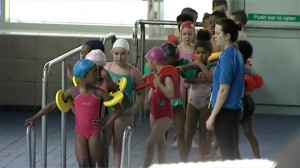Over 1.1 million primary school children will break up for half term next week unable to be safe in and around water
That’s according to a report released today by Swimming’s Governing Body, the ASA (Amateur Swimming Association) and Kellogg’s entitled “Learning the Lesson – The Future of School Swimming”, which surveyed 3,501 primary schools on how many of their children have attained Key Stage 2 swimming requirements. It found 51% of children aged seven to eleven cannot swim the length of a typical swimming pool (25 metres) unaided.
The report, the largest ever investigation into the state of school swimming, found that schools are not achieving anywhere near the recommended level of delivery time. The average state school pupil spends just 8 hours and 15 minutes a year in swimming lessons at school, which is well under the 22 hours The Department for Education recommends in the current National Curriculum.
But a lack of monitoring by Ofsted means that schools are not required to show any evidence of their swimming programmes. With schools increasingly under pressure to deliver good exam results there are concerns that head-teachers and school governors are not allocating budget to support swimming in the National Curriculum, preferring to concentrate on academic indicators instead.
With drowning amongst the leading cause of accidental death of children and young people in England (according to the Royal Society for the Prevention of Accidents), experts are worried these numbers could increase in future if the current issues with school swimming programmes are not addressed. In 2011 there were 407 deaths from drowning reported across all age groups, of which 47 involved children and young people under the age of 19-years-old.
Where schools are achieving high attainment rates amongst their pupils it is attributed to better pupil to teacher ratios, longer lesson times and a higher number of lessons offered. The report concludes that budget constraints in schools and a lack of auditing by Ofsted to ensure schools are delivering swimming programmes, as set out by the Department for Education, are at the heart of the problem.
Almost 45% of schools stated the biggest barrier to delivering better quality school swimming was budget constraints.
This September each primary school will receive a minimum of £9,000 additional ring-fenced funding as part of the Government’s £150 million injection into PE & School Sport. The ASA is calling for curriculum swimming and water safety to be a priority for this funding, with schools that are not currently meeting the statutory requirement to ensure that every child has the opportunity to swim 25 metres by the time they leave primary school.
To coincide with the ASA report over a thousand parents of primary school children were surveyed for their thoughts on the state of school swimming. The research highlighted that despite swimming’s place on the national curriculum just four in ten parents say their child is currently receiving lessons at school. And over half of parents wanted the new additional Government funding to help rectify this by putting school swimming over and above other sports.
There has also been a decrease in the number of children leaving school able to swim 25 metres; with 40% of parents of children currently in year 6 saying their child cannot swim the statutory requirement set out by Government, compared to 1 in 3 identified in the 2012 ASA School Swimming Census last year.
One in ten parents say their child only swims on holiday – presenting clear risks in terms of ability, water confidence and safety – especially when 52% of parents do not think or are not sure if their child could swim to safety if they found themselves in danger in open water. 39% of parents also told the ASA that their child was not in any type of swimming lessons.
The ASA, whose 2012 “Save School Swimming: Save Lives” report laid down a six point manifesto to provide direction for everyone involved in delivery school swimming is also urgently calling for the Government to ask Ofsted to include the inclusion and monitoring of compulsory swimming lessons as part of primary school inspections, as well as offering more training for teachers.
Commenting David Sparkes, Chief Executive of the ASA (Amateur Swimming Association) said, “Swimming is one of the easiest, safest forms of exercise for children of all abilities, and school swimming is the single most effective way of teaching children how to be safe in and around water. Yet swimming is one of the few areas of a child’s statutory education that is all too often left unmeasured, unchecked or, for 1.1m children, unfulfilled.
“The additional £150m of ring-fenced investment by Government for PE and School Sport this September can provide a real lifeline for school swimming. I believe that schools have a rare opportunity to seize the moment in September 2013, and take action by investing in an activity that has a lifelong legacy and the ability to keep future generations safe”.
David Walker, leisure safety manager at the Royal Society for the Prevention of Accidents (RoSPA), said: “RoSPA is astounded at how bad some of these figures are.
“Having the swimming and water safety skills to save yourself or others doesn’t come instinctively, it has to be taught.
“Worryingly, in our work with bereaved parents and coroners, RoSPA hears all too often how parents believed their children could swim, only to find out their abilities were little more than being able to float and doggy paddle.
“RoSPA supports all the ASA’s recommendations including its call for curriculum swimming and water safety to be a priority in schools.”

One thought on “Children at risk as report finds more than half of children cannot swim”